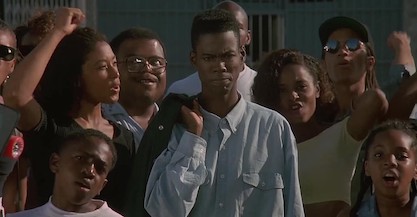The Number One Movie in America: CB4
By Sean Collier
August 7, 2020
While this column and its associated podcast puts an awful lot of weight on a film becoming the “number one movie in America,” that crown is often bestowed somewhat arbitrarily.
We define that distinction as occurring when a film wins the domestic box-office for any given Friday-Sunday period. (Until this year, anyway.) This makes for some odd title holders; you can become a box-office champion by raking in hundreds of millions, or from muscling out the competition in a crowded multiplex.
You can also just play to the right audience on a fairly slow weekend — and even then, in the case of “CB4,” it could be a virtual tie.
“CB4,” a parody of early hip-hop media starring and co-written by Chris Rock, was released March 12, 1993. It finished that weekend with $6,122,450 in the bank. Why am I offering such a specific number? Because the runner up, the mostly forgotten alien-abduction drama “Fire in the Sky,” earned $6,116,484.
It’s one of the closest photo finishes in box-office history. Less than $6,000 separated #1 and #2.
Does it make a difference in the long run? Not particularly; while “CB4” probably got a boost by claiming the title of box-office champ, that added marketing muscle can’t have amounted to much. The film eventually earned a bit less than $18 million; given a small budget, it was a modest hit and provided momentum to Rock’s growing comedy career.
“CB4” is an above-average spoof mostly notable for delivering commentary that was well ahead of its time. While it dallies occasionally in easy (and retroactively problematic) jokes, it aims its satire squarely at the media reaction to gangster rap and the growing influence of hip-hop culture, skewering the fetishization of MTV and the pearl-clutching of reactionary politicians in equal measure. 1993 was early for a mainstream movie to be pushing back against the great media’s treatment of rap; considering that myths were still being dispelled decades later by “Straight Outta Compton,” “CB4” can only be considered prescient.
Incidentally, it’s not alone in this: In one of the most unlikely “Dante’s Peak”/“Volcano” concurrences on the record, another hip-hop satire came out the same year. “Fear of a Black Hat” also used a fictionalized N.W.A. as its subject matter; it was made first and gained buzz on the festival circuit, but “CB4” premiered first and was a much bigger hit.
How did an incisive, R-rated blend of satire and social commentary become the top movie in the country (other than a relatively weak marketplace that month)? Underserved demographics. Even 27 years later, movies targeted at Black audiences represent a too-small fraction of studio releases. In 1993, this was even more profound; defining which movies are targeted at specific demographics is tricky, but there were almost certainly fewer than 10 such releases from the studios that year.
When movies like “CB4” dominate the box-office charts, legacy publications often react with a surprise; the tracking didn’t have them as winners, they say. Finally, that surprise is starting to lessen (remember “Black Panther”) as the studios begin to wake up: When audiences who are often ignored are better served, they tend to buy tickets.
Perhaps that knowledge will help guide the studios when the theaters open again. History doesn’t tell us to count on it, but it’s something to hope for.
“CB4” is the subject of the latest episode of The Number One Movie in America, a look back at past box-office champions. Each episode’s film is drawn at random from a list of every number-one movie since 1982. Please listen and subscribe!
Next time: It took a nearly unwatchable, 154-minute bomb to finally derail one of the biggest franchises of the 21st century.




